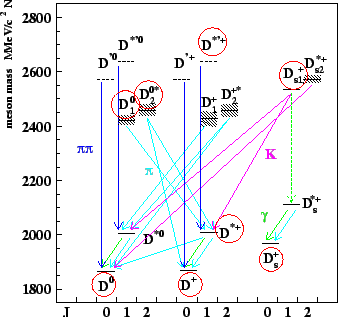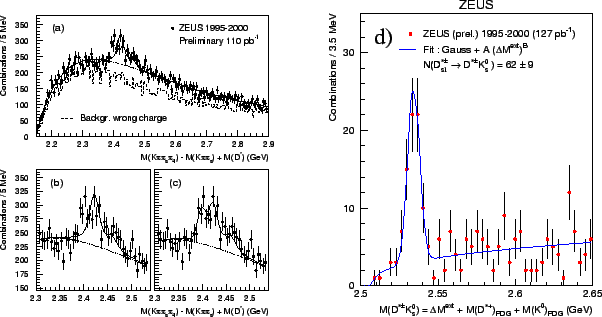



Next: Searches for New States
Up: Spectroscopy
Previous: Spectroscopy
Contents
In fig.49 the various  -meson states are shown.
-meson states are shown.
Figure:
Overview of the known  -Meson states.
The three columns show the states with
-Meson states.
The three columns show the states with
 ,
,  and
and  for angular momenta
for angular momenta  , respectively.
The circles indicate those states which have been studied so far at HERA.
, respectively.
The circles indicate those states which have been studied so far at HERA.
 |
ZEUS has reconstructed the resonances  and
and  in the
decays into
in the
decays into
 (fig.50a) [49].
The fraction of
(fig.50a) [49].
The fraction of  mesons produced
in decays from
mesons produced
in decays from  and
and  was determined
to be at the level of 3.4 and 1.4%, respectively.
In the same analysis, the production rate
of
was determined
to be at the level of 3.4 and 1.4%, respectively.
In the same analysis, the production rate
of  mesons in charm fragmentation was
determined to be less than 0.7% (95%C.L.).
mesons in charm fragmentation was
determined to be less than 0.7% (95%C.L.).
Figure:
The distributions of a-c)  and
d) of
and
d) of
 .
Here,
.
Here,
 and
and
 and
and
 are the nominal masses of the
are the nominal masses of the
 and
and  , respectively.
, respectively.
 |
ZEUS also measured the production of the
excited charm-strange meson
 using its decays into the final state
using its decays into the final state
 [50].
In fig.50b the invariant mass distribution
of
[50].
In fig.50b the invariant mass distribution
of
 candidates is shown.
The fraction of
candidates is shown.
The fraction of  quarks hadronizing as
quarks hadronizing as
 mesons
was determined to be
mesons
was determined to be
 .
.




Next: Searches for New States
Up: Spectroscopy
Previous: Spectroscopy
Contents
Andreas Meyer
2006-02-13
![]() -meson states are shown.
-meson states are shown.

